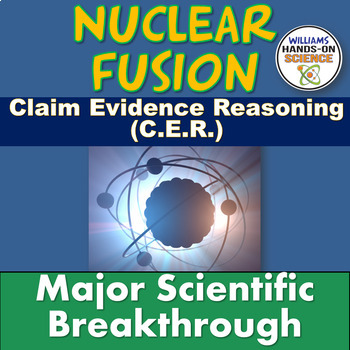Nuclear Fusion Claim Evidence Reasoning CER NGSS Definitions of Energy
- Zip
Description
Students learn how scientists finally made a breakthrough with nuclear fusion through a C.E.R. (Claim Evidence Reasoning) graphic organizer. This is great for getting your students to explain phenomena in a meaningful way and it allows you as the instructor to adequately assess their understanding of concepts. The students figure out what the "Claim" is in the article, they then use data that supports the claim in the "Evidence" section, draw visual evidence and then explain why the evidence supports the claim in the "Reasoning" section.
The article has the following concepts:
Nuclear Fusion
Megajoules
Carbon-free Energy
Energy
Isotopes
Photons
Atoms
Plasma
Magnetic Fields
X-rays
Main-Sequence Stars
Radioactive
Global Warming
Take a look at my CER Mega bundle!
This is great for a current event, sub plan, homework, critical thinking, scaffolding and/or reinforcement of concepts!
You get a CER graphic organizer, an editable key, the article, tips for CER and the link to the website in the article.
NGSS Standards:
PS3.A: Definitions of Energy
• The term “heat” as used in everyday language refers both to thermal energy (the motion of atoms or molecules within a substance) and the transfer of that thermal energy from one object to another. In science, heat is used only for this second meaning; it refers to the energy transferred due to the temperature difference between two objects. (secondary to MS-PS1-4)
• PS1.A: Structure and Properties of Matter
• Each atom has a charged substructure consisting of a nucleus, which is made of protons and neutrons, surrounded by electrons. (HS-PS1-1)
• PS1.C: Nuclear Processes
• Nuclear processes, including fusion, fission, and radioactive decays of unstable nuclei, involve release or absorption of energy. The total number of neutrons plus protons does not change in any nuclear process. (HS-PS1-8)
• PS3.A: Definitions of Energy
• Energy is a quantitative property of a system that depends on the motion and interactions of matter and radiation within that system. That there is a single quantity called energy is due to the fact that a system’s total energy is conserved, even as, within the system, energy is continually transferred from one object to another and between its various possible forms. (HS-PS3-1), (HS-PS3-2)
• ETS1.A: Defining and Delimiting Engineering Problems
• Criteria and constraints also include satisfying any requirements set by society, such as taking issues of risk mitigation into account, and they should be quantified to the extent possible and stated in such a way that one can tell if a given design meets them. (secondary to HS-PS2-3)
•
SEP's
Asking Questions and Defining Problem:
Students at any grade level should be able to ask questions of each other about the texts they read, the features of the phenomena they observe, and the conclusions they draw from their models or scientific investigations.
Engaging in Argument from Evidence:
In 9–12 builds on K–8 experiences and progresses to using appropriate and sufficient evidence and scientific reasoning to defend and critique claims and explanations about the natural and designed world(s). Arguments may also come from current scientific or historical episodes in science.
Construct an explanation based on valid and reliable evidence obtained from a variety of sources (including students' own investigations, models, theories, simulations, peer review) and the assumption that theories and laws that describe the natural world operate today as they did in the past and will continue to do so in the future. (HS-ESS1-2)
CCC1: Patterns
Observed patterns of forms and events guide organization and classification, and they prompt questions about relationships and the factors that influence them.
Systems and System Models
Models (e.g., physical, mathematical, computer models) can be used to simulate systems and interactions—including energy, matter, and information flows—within and between systems at different scales. (HS-LS2-5)
Energy and Matter
Changes of energy and matter in a system can be described in terms of energy and matter flows into, out of, and within that system. (HS-LS1-5), (HS-LS1-6)
Energy cannot be created or destroyed—it only moves between one place and another place, between objects and/or fields, or between systems. (HS-LS1-7), (HS-LS2-4)
Energy drives the cycling of matter within and between systems. (HS-LS2-3)
TERMS OF USE
• All rights reserved by Williams Hands On Science, Inc.
• This product is to be used by the original purchaser only.
• Intended for classroom and personal use only.
• Copying for more than one teacher, classroom, department, school, or school system is prohibited.
• This product may not be distributed or displayed digitally for public view.
• Failure to comply is a copyright infringement and a violation of the Digital Millennium Copyright Act (DMCA).
If there are any errors or questions, please contact me through TpT or email me at:
williamshandsonscience@gmail.com
Thank you for taking a look!
Please follow me on TpT for new products and check me out on Instagram for my products in action!
https://www.instagram.com/williams_hands_on_science/
Related Products
⭐ Claim Evidence Reasoning (CER): Autumn Equinox Can Fall on Different Days
⭐ Claim Evidence Reasoning Growing Bundle
⭐ NGSS Black Holes & Galaxies Claim Evidence Reasoning Graphic Organizer
⭐ NGSS Claim Evidence Reasoning (CER) Big Bang Graphic Organizer
⭐ NGSS Claim Evidence Reasoning (CER) High Frequency Sound Waves
⭐ NGSS Claim Evidence Reasoning The Mysterious Planet Nine Solar System Astronomy
⭐ NGSS Claim Evidence Reasoning (CER) Water Found on Mars
⭐ ⭐ NGSS Common Core Claim Evidence Reasoning (CER) Graphic Organizers
⭐ NGSS Expanding Universe Claim Evidence Reasoning Graphic Organizer





